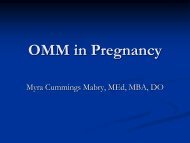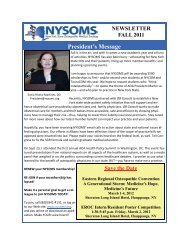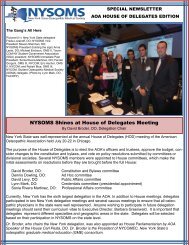Abstract Proceedings EROC 2011 - New York Osteopathic Medical ...
Abstract Proceedings EROC 2011 - New York Osteopathic Medical ...
Abstract Proceedings EROC 2011 - New York Osteopathic Medical ...
Create successful ePaper yourself
Turn your PDF publications into a flip-book with our unique Google optimized e-Paper software.
<strong>EROC</strong> <strong>2011</strong> <strong>Abstract</strong> <strong>Proceedings</strong> – March 4, <strong>2011</strong><br />
Dept. of Emergency Medicine, <strong>New</strong>ark Beth Israel <strong>Medical</strong> Center, <strong>New</strong>ark, NJ<br />
Title: Supraventricular Tachycardia in Pregnancy<br />
Author: Eli Cohen, DO<br />
<strong>New</strong>ark Beth Israel <strong>Medical</strong> Center, Department of Emergency Medicine, <strong>New</strong>ark, NJ 07112<br />
Introduction: Arrhythmias are the most common cardiac complication occurring during<br />
pregnancy in women without structural heart disease. Paroxysmal supraventricular tachycardia<br />
(SVT) is the most common arrhythmia in pregnancy with conservative incidence of 4%. This<br />
case is of interest because pregnancy has been identified as a risk factor for paroxysmal SVT.<br />
When SVT fails to be self limited or hemodynamic compromise arises, immediate intervention is<br />
necessary to prevent harm to mother and fetus.<br />
Case Description: A 41-year-old African American female presented to the emergency<br />
department with palpitations for 2 days. Associated symptoms included fatigue, urinary<br />
frequency and two weeks of left flank pain. Otherwise, patient denied fever, nausea, vomiting,<br />
chest pain or shortness of breath.<br />
Physical examination was remarkable for pulse 208 bpm, blood pressure 128/77, room air pulse<br />
oximetry 98%. Heart sounds were significant for a regular tachycardia. Patient’s abdominal and<br />
back exam was significant for left CVA tenderness. Otherwise, no jugular venous distention,<br />
palpable thyromegaly, lower extremity edema or calf tenderness was noted.<br />
Initial electrocardiogram revealed supraventricular tachycardia at 206 bpm with left ventricular<br />
hypertrophy. Patient was given adenosine 6mg IV rapid push with immediate resolution of<br />
tachyarrythmia. Repeat electrocardiogram revealed normal sinus rhythm at 98 bpm, normal axis,<br />
with left ventricular hypertrophy. Laboratory analysis revealed mild white blood cell count<br />
elevation with normal differential and a positive urine pregnancy test. Bedside transabdominal<br />
ultrasound revealed an intrauterine fetal yolk sac with absence of free pelvic fluid. Patient was<br />
monitored for several hours following cardioversion and discharged home.<br />
Discussion: This case illustrates the importance of understanding cardiac arrhythmias during<br />
pregnancy. Prompt intervention ensures positive outcome for mother and fetus. When<br />
hemodynamically stable, acute episodes of SVT in pregnancy may be terminated by blocking<br />
AV nodal conduction. Additional emphasis on the frequency and management of cardiac<br />
arrhythmias during pregnancy is needed.<br />
48











